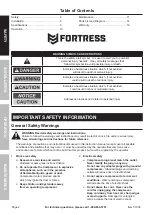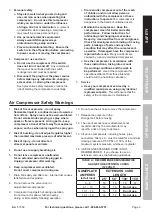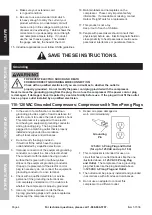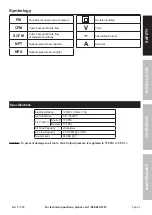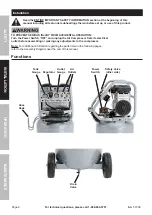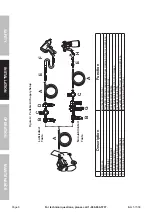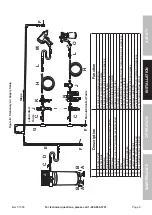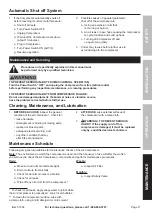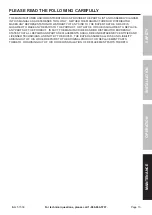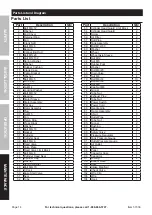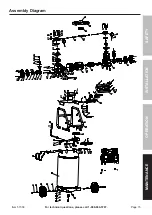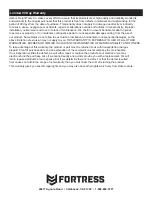
Page 10
For technical questions, please call 1-888-866-5797.
Item 57336
SA
FE
TY
OP
ERA
TI
O
N
MAINT
ENANC
E
IN
ST
ALLA
TI
O
N
Operating Instructions
Read the ENTIRE IMPORTANT SAFETY INFORMATION section at the beginning of this
manual including all text under subheadings therein before set up or use of this product.
Compressor Area Set Up
1. Designate a work area that is clean and well-lit.
The work area must not allow access by
children or pets to prevent injury.
2. Locate the Compressor on a flat level surface to
ensure proper pump lubrication and to prevent
damage to the unit. Keep at least 12
″
of space
around the unit to allow air circulation.
3. Route the power cord from the compressor
to the grounded wall outlet, along a safe path
without creating a tripping hazard or exposing
the power cord to possible damage.
General Operation
1. Close the Drain Valve.
2. Close the in-line Shutoff Valve between
the compressor and the air hose.
3. Plug the Power Cord into a grounded
120 VAC electrical outlet.
4. Pull the ring on Safety Valve to release pressure.
5. Turn the Power Switch ON (AUTO) .
6. Allow the Air Compressor to build
up pressure until it cycles off.
Note:
At the beginning of the day’s first use
of the Air Compressor, check for air leaks by
applying soapy water to connections while the
Air Compressor is pumping and after pressure cut-
out. Look for air bubbles. If air bubbles are present
at connections, tighten connections. Do not use the
Air Compressor unless all connections are air tight,
the extra air leaking out will cause the compressor to
operate too often, increasing wear on the compressor.
Note:
As long as the Power Switch is ON (AUTO), the
operation of the Air Compressor is automatic, controlled
by an internal pressure switch. The Compressor will
turn on automatically when the air pressure drops to 135
PSI, and will turn off automatically when the
air pressure reaches 175 PSI.
WARNING! TO PREVENT SERIOUS
INJURY AND DEATH FROM
EXPLOSION:
Do not adjust the internal
pressure switch.
Any change to the
automatic pressure levels may cause excess pressure to
accumulate, causing a hazardous situation.
7. Pull out the Regulator and adjust so that the air
output is enough to properly power the tool, but
the output will not exceed the tool’s maximum air
pressure at any time. Turn the knob clockwise to
increase the pressure and counter-clockwise to
decrease pressure. Adjust the pressure gradually,
while checking the air output gauge to set the
pressure. Push in Regulator when finished.
8. Make sure the air tool’s throttle or switch is in the
off position. Connect the air tool to the air hose.
9. Open the in-line Shutoff Valve.
10. Use the air tool as needed.
11. After the job is complete, turn the Power Switch OFF.
12. Unplug the Air Compressor.
13. Close the in-line Shutoff Valve.
14. Bleed air from the tool then disconnect the tool.
15. Drain Tank according to
Draining Moisture
from the Tank on page 12.
16. Clean, then store the Air Compressor indoors.
Emergency Depressurization
If it is necessary to quickly
depressurize
the Compressor, turn the Power Switch OFF.
Then, pull on the ring on the Safety Valve to quickly release stored air pressure.


